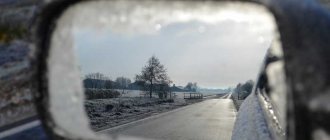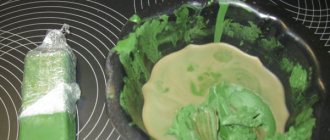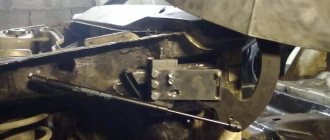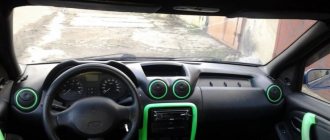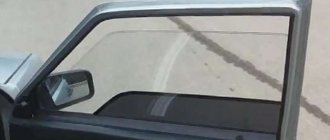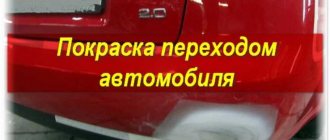You can make your own anti-rain from silicone spray, paraffin with solvent, WD-40, Lenora, or even construction sealant. At the same time, in terms of functional qualities, the finished product will hardly differ from the best factory version. Below we present the main ways to make anti-rain for a car with your own hands, we present basic recipes and their features. Let's consider what such compositions are usually prepared from, what are the pros and cons of each option. Talk separately about the rules for applying such products to a car.
How to make anti-rain with your own hands
There are several ways to make a homemade anti-rain and thereby save money on purchasing an original product. Below we present the most popular options, which have many positive reviews and are considered the most attractive among car owners.
Silicone spray
When considering options on how to make anti-rain for car glass yourself, it is worth highlighting a solution with silicone glue. This lubricant is very similar in composition to polymer silicone, and after it gets on the surface of the glass, it forms a protective layer and fills all the unevenness on the surface. It also has excellent hydrophobic properties.
The disadvantages of silicone spray include a short service life (it washes off quickly), the need for high-quality cleaning before processing, a negative effect on paintwork and the requirement for mandatory rubbing/polishing.
Paraffin and solvent
No less popular is paraffin anti-rain, which everyone has on their household. In addition to the paraffin itself, you will also need white spirit. If you don’t have a candle at hand, you can replace it with a liquid paraffin composition.
Now let's look at how to make anti-rain for glass with your own hands. The algorithm is like this:
- Grind the candle using a grater or knife. This is necessary to speed up the process of dissolving paraffin.
- Take 10 g of paraffin and fill it with 200 ml of white spirit.
- Mix the resulting composition and wait until completely dissolved.
- Apply anti-rain composition for car windows to the surface.
- Using a cloth or soft cloth, polish the surface until transparent.
Please remember that the use of other solvents is not recommended and may damage the paintwork.
WD 40
If paraffin and white spirit are not suitable for DIY anti-rain, use WD 40. This is a universal product that has excellent hydrophobic properties and can protect the surface of the car from snow and rain. It must be applied to a dry/clean surface and then rubbed in. To ensure stable protection, the frequency of treatment is once every 10 days.
Lenore
To make anti-rain for car glass with your own hands, you can use a recipe using Lenore. This is a standard concentrate with a good water-repellent effect. After treating the surface, moisture rolls off and does not linger on the surface, and making the product yourself is not difficult.
The algorithm of actions is as follows:
- Prepare Lenore, distilled water and an empty mixing container.
- Pour a Lenore cap into the empty bottle.
- Add 3-4 liters of water and mix everything.
- Pour the product into the windshield wiper tank.
- Treat the windshield through the nozzles.
The main disadvantage of this anti-rain folk remedy is the appearance of a bluish film on the windshield. At night the plaque is almost invisible, but in the daytime it can impair visibility.
Construction sealant
To make an anti-rain windshield with your own hands, you can use construction sealant. This is another product that easily copes with liquid repulsion and is made on a silicone basis. To make it, do the following:
- Take 50 g of white spirit solvent.
- Measure out a teaspoon of construction sealant (preference should be given to neutral compounds).
- Mix everything in a clean container until smooth.
To apply anti-rain for a car body made by yourself, it is better to use a sprayer, and then carefully distribute the composition over the surface. At the same time, the product does not leave streaks / marks, protecting against contamination.
A little about resource and safety
Cameras are certainly good, but this composition was created in order to extend the life of the windshield wipers, as well as for safety reasons
RESOURCE – ask me – “how is it extended”? It’s very simple, you need to turn on the windshield wipers less often (the droplets drain on their own, especially at speed), so the wear of both the rubber bands and the windshield is reduced (and the “windshield” can also be wiped over time). Also, the film that forms reduces the physical impact of rubber on glass.
Safety - as I wrote above, over time, the car windshield wears out, small scratches appear (especially after scraping in winter), and the surface itself becomes rough. Water and dirt adhere to such a surface much better than on a similar new one. Accordingly, all this impairs visibility and visibility (especially on the sides of the glass); again, anti-rain creates a film that does not allow dirt to settle unnecessarily, indirectly cleaning the surface
As you understand, this is a useful thing, and often harmless both for paintwork (paint and varnish coating), and for plastic and glass. And it really works
What is anti-rain made of?
Many questions concern what official manufacturers make anti-rain from. In most cases, silicone-based polymers and solvents are used. The composition may also include additional chemical components that provide high wear resistance to the layer. Depending on the composition, the validity period of the product can be adjusted, which reaches six months. If you make the product yourself from the ingredients discussed above, the service life will be shorter.
Popular brands
Many manufacturers of automotive chemicals rightly believe that anti-rain is the best option for ensuring optimal visibility during precipitation. The rating is based on the speed at which drops roll off the windshield and the time during which the chemical composition will remain on the glass without reapplication. Today you can choose inexpensive products from the following brands:
- Trico Enduroshield;
- Liqui Moly;
- Turtle Wax;
- Aquapel etc.
There is an alternative option - to make a water-repellent composition yourself from various household chemicals.
Turtle Wax
Anti-rain Turtle Wax Clear is one of the most popular, despite the cost, water-repellent compounds. Produced by a British company, the release form is a 300 ml bottle, the average cost is from 300 rubles. Anti-rain "Vax" is made of odorless synthetic silicones. Simply applying to glass using felt cloth will provide excellent visibility during rainfall for 6 months (manufacturer's warranty).
It is not recommended to apply “Turtle” to the varnish coating of the body and the surface of the headlights: the chemical components of the product are not compatible with plastic.
Turtle Wax Anti-Rain should not be applied to tinting films without first checking the compatibility of the material.
Procedure for processing windshield and side windows:
- The surface is thoroughly washed and dried.
- A few drops of the composition are poured onto felt or cotton fabric.
- Using circular movements, the water repellent is applied to the glass.
- After drying and the formation of a matte coating, the procedure is repeated.
- The glass is dried.
- Be sure to wet it with water.
- The surface of the glass is polished with a soft cloth.
If you do not wet the glass with water before polishing, the coating may become cloudy.
Aquapel
Anti-rain Aquapel is available in the form of an applicator with a capsule of the active substance. A sponge is included for quick application. The silicate-based water repellent forms a transparent layer on the glass that protects the windshield for up to 10 months.
Comparison of folk remedies and purchased ones (pros and cons)
With this in mind, the question arises which product is better to choose - official or homemade. To do this, you need to understand the advantages and disadvantages of each option.
Official product
Pros:
- Application of tested technology.
- Long service life.
- Efficiency guaranteed.
- Convenient containers and a large selection of all kinds (from washer fluid in the washer reservoir to special film).
- Ready for application.
Minuses:
- Additional expenses.
- It's hard to wash off glass.
- You need to analyze the characteristics, read reviews and buy.
With your own hands
Pros:
- Minimum expenses.
- Use of improvised means.
- Possibility to choose one of many options.
Minuses:
- Risk of damage to glass and body.
- Questionable effectiveness.
- Low service life.
Experience of car enthusiasts
I used High Gear, I liked the effect, but not for long, on average it was enough for a week in normal weather, in rainy weather for 3-4 days. It's been on my brother's side windows for six months now, the effect is amazingly visible. I heard that RainX is for sale somewhere in METRO, I'm looking for it. In England, the guys only use it.
Brain
https://forum.car-care.ru/index.php?showtopic=45
Made by turtle, it rubs in without leaving a residue, lasts about 3 months. All glass is rubbed in half an hour, a very convenient thing. Costs a penny, no cons found. There are left-wing anti-rains, but you get tired of applying them, you rub and rub, and the glass is covered in a whitish coating.
506
https://highlander-autoclub.ru/forum/index.php?threads/Antidozhd.10348/
I apply the usual anti-rain from Turtle and someone else. I apply it myself, the method is simple, but it lasts for a maximum of a month - this is ideal, but 2 weeks is good, then the effectiveness drops considerably, but it’s done quickly: I washed the glass, applied it, rinsed it, wiped it off.
RRC
https://highlander-autoclub.ru/forum/index.php?threads/Antidozhd.10348/
Turtle Wax is quite an anti-rain medicine - ours, cheap, cheerful, helps a little. Runway Rain - quite enough, at work they give it. Aquapel - spoiled. Q2 View - very expensive, good, they used to give it at work, then they stopped.
Lokot
https://wroom.ru/index.php?id=forumtopic&topic=18523
It is quite popular among car enthusiasts to independently prepare “anti-rain”. This is due to the low cost of the components and their efficiency. In addition, special skills are not required to obtain this or that composition. Every car owner can prepare such a product, since it will require a minimum of time and financial costs.
How to apply on glass
Regardless of where the anti-rain was taken - made with your own hands or bought in a store, the principle of application is identical in all cases. Take the following steps:
- Wash the entire car well with clean water.
- Apply ammonia cleaner to the glass.
- Rub the surface until it is shiny and streak-free.
- Leave the glass to dry.
- Apply anti-rain with your own hands.
- Wait for it to dry.
- Polish until completely transparent.
Remember that when applying, do not use hard rags or sponges, which can leave scratches on the surface.
Now you know how to make anti-rain with your own hands, what are the features of each method, and is it worth the risk of creating a solution. In the comments, tell us what method you used and what other methods of making glass protection can be used.
I want to say two things
First, you can now tell me: “The branded anti-rain, which is sold in bottles of 250-300 ml, is actually more than our small bottle of 15 ml.”
Friends, yes, this is all true, all this is true, but, firstly, this bottle costs 200-500 rubles, and secondly, it contains diluted silicone, that is, it is diluted with some kind of surfactant.
A very small percentage of silicone is taken there, maybe the same amount as in this 15 ml bottle, and everything is diluted with surfactants so that you can apply it normally to your windshield.
Here the silicone comes undiluted, concentrated, and you apply these really small droplets to the surface that needs to be treated and rub it.
It works even better than the branded one in a can that needs to be sprayed.
Results of use
Professional drivers are skeptical about water-repellent agents and practically do not use anti-rain coating for work vehicles. At speeds up to 70 km/h, the product does not work. They clean the windshield as standard using windshield wipers and branded windshield wipers.
Many drivers who systematically treat their cars note that if there is heavy rainfall outside, they still cannot do without wipers. Any anti-rain really becomes useless when driving around the city, but works great at high speeds. The undeniable advantages of silicone coating:
- The treated surface is easier to wash and clean. This is especially noticeable in winter, when you have to clear snow from the windows.
- Does not wash off after standard manual washing. The certified product can withstand up to 10 contactless washes.
- After the rain there are no stains or streaks left from dried drops.
- Clear movement of frameless wipers due to the fact that the glass surface has become slippery.
Whether to use anti-rain or not, each motorist chooses independently. The advantages of the new composition, which increases the comfort of driving the machine, are undeniable.
